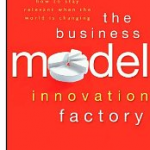Jun18
Chesbrough on Open Services Innovation #WIFNY
Point: Provide customers with toolkits to help them create new products and services.
Story: I’m looking forward to hearing Henry Chesbrough, originator of the term “open innovation,” speak at the World Innovation Forum tomorrow.
In his latest book, Open Services Innovation, Chesbrough writes about co-creating with your customers, particularly in services where it’s harder for customers to specify what they want because so much of the experience is tacit. Whereas innovative physical products can excel on objective measurable performance, innovative services often entail a greater degree of subjective perceptions.
services where it’s harder for customers to specify what they want because so much of the experience is tacit. Whereas innovative physical products can excel on objective measurable performance, innovative services often entail a greater degree of subjective perceptions.
What’s exciting for innovators is that precisely because the information is tacit, finding ways to elicit or manage that tacit information will bring strategic advantage. One way that customers can “tell” you this tacit information is through their behavior, which in most cases is through their purchase and usage patterns. If customers have a good subjective experience, they do it again; if the service was bad, they don’t come back. Yet passive observation can be hard to interpret, can miss a lot, and is better at providing feedback on existing offers than for creating true innovation.
A better solution is for companies to actively encourage open feedback and ideas from customers. As Chesbrough says, “When customers tell you – rather than everyone else — their tacit needs, you have a unique insight that can help you differentiate yourself in the market.” Companies that can find ways to engage customers to co-create — or that can create systems that elicit such tacit knowledge — accrue benefits. LEGO, the building-brick toymaker, is one such company.
LEGO created a software toolkit and online space for customers to create and share new designs that go far beyond what’s possible with the manufactured physical product. The components of the toolkit and space include “LEGO Digital Designer” software, “My LEGO Network” for children, and a 4.2 million-member LEGO Club. The social media elements, design contests and customer-created galleries let LEGO fans of all ages build and share ideas.
In turn, LEGO gains tacit information into what customers really want to build, which supports LEGOs product development efforts. For example, LEGO got the idea to sell kits of leading architectural designs from around the world, such as the Empire State Building, the Taj Mahal or Frank Lloyd Wright’s Fallingwater home. Not only were many of these designs created by users, but LEGO gained entry to a new market — adults — which it had not envisioned nor would have initiated internally.
What Chesbrough is talking about is a kind of meta-innovation — an innovation in the innovation process. Open services innovation converts innovation from an internal process into an external service. Providing customers with a toolkit for self-expression not only satisfies customers but also creates an incoming flow of tacit knowledge about customers and about new ideas that may be more widely implementable.
Action:
- Watch the trail of breadcrumbs left by customers to uncover tacit knowledge and subjective performance indicators
- Actively solicit feedback to understand why customers do what they do — and what they want you to do.
- Create a toolkit or sandbox where customers can create their own products and services
- Make innovation an external service your company provides to customers
Sources:
Special thanks to Walden University for sponsoring the May 8, 2012 webinar with Henry Chesbrough as a prequel to his presentation at the World Innovation Forum.
Comments Off on Chesbrough on Open Services Innovation #WIFNYCase study, How-to, Innovation, open innovation










